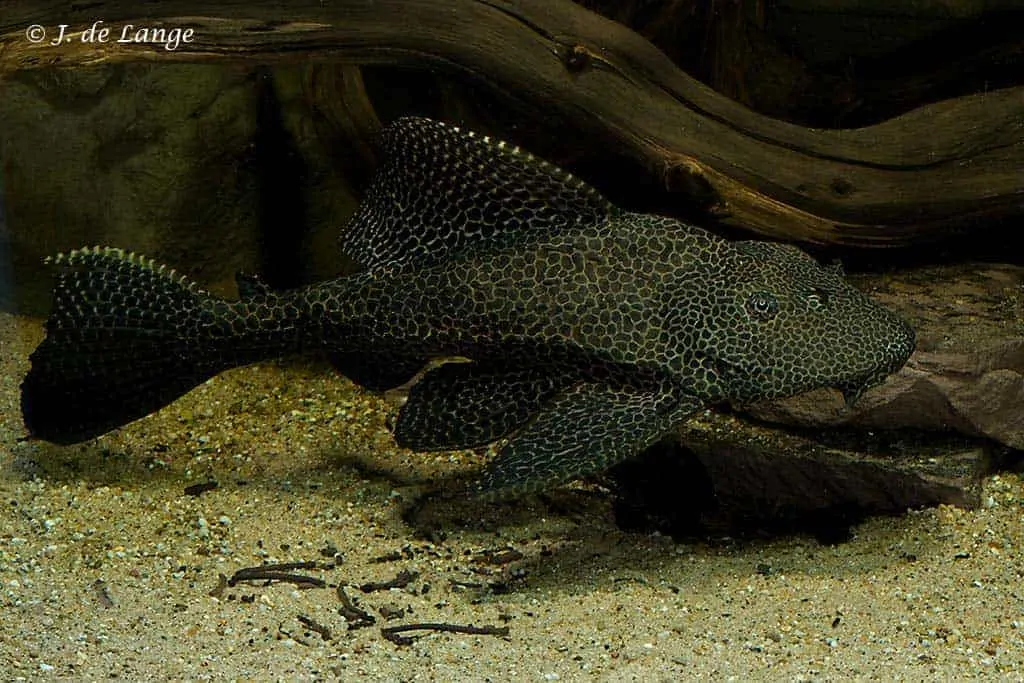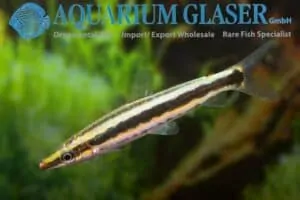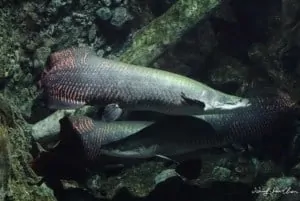Pterygoplichthys gibbiceps – Sailfin Pleco
Pterygoplichthys gibbiceps or Sailfin Pleco by its common name was officially described in 1854 by Kner. They can also be found with their L-numbers L083 and L165.
The genus name Pterygoplichthys consists of three Greek words. Pterygion is a diminutive of the pteryx which means “wing”; Hoplon means “weapon” and ichthys means “fish”. A reference to the large dorsal fin in this genus.
The species name gibbiceps can be divided into two pieces: “gibbus” meaning “hump” and “kephale” meaning head. This is a reference to the hump on the back of their heads.
A part of this genus has been separated into a different genus called Glyptorichthys with the hump on the back of their head as the most important difference. Part of being a different genus is that it has a unique feature setting it apart from other genera. As this was not the case in the genera Glyptoperichtys, Liposarcus, and Pterygoplichthys they have now been merged into one genus: Pterygoplichthys.
Synonyms: Ancistrus gibbiceps, Glyptoperichthys gibbiceps, Liposarcus altipinnis.
Description
Pterygoplichthys gibbiceps can reach a total length of around 50 to 80 centimeters in an aquarium. This fish grows out to be a very large inhabitant that can be found mainly at the bottom of your aquarium. Their colors vary from brown to black with a white/yellow army print on top of that. As the Sailfin Pleco matures, their spots get smaller.
One of the unique features of this genus is their very large dorsal fin which they can fold down entirely. The dorsal fin of this genus has 9 or more dorsal fin rays whereas other genera of the Loricariidae family have 8 or fewer dorsal fin rays. This makes it easier to find the difference between for instance Pterygoplichthys gibbiceps and Hypostomus species.
They use their downward-facing mouth to as a sucker to hold on to the substrate. The lips are covered with small teeth. They use these teeth to scrape algae off wood, rock, or plants.
In shops, they are often sold at a length of just a few centimeters. Usually they “forget” to tell you that the Sailfin Pleco can grow to a formidable length and needs a very large aquarium. So pay attention before you buy a small “algae eater”, ask for their real scientific name, and get some information about the fish before you buy them.
Pterygoplichthys gibbiceps usually is a peaceful fish that is a good match with most smaller fish, they ignore other bottom-inhabiting fish. It is a very strong fish that can uproot a plant from time to time but they won’t eat healthy plants. All fish that try to enter their cave will be chased away. They prefer to have multiple caves in the aquarium. They are nocturnal fish so they are most active around dusk and night. They can be territorial towards conspecifics.
Sexing them is hard for all but the trained eye. The male’s genital papilla is protruding like a small thump whereas the females are flat or even recessed a bit.
Origin
Pterygoplichthys gibbiceps can be found in Peru, Ecuador, Brazilië, Venezuela. They are common in the upper- and middle of the Amazon basin and can be found in the Rio Orinoco basin.
The Aquarium
An adult Pterygoplichthys gibbiceps or Sailfin Pleco needs a spacious aquarium of at least 200 centimeters in length. They like dimmed lighting and lots of hiding places. They like to hide during the day so provide them with some spacious caves or very dense planting. Keep in mind they are very strong fish that can uproot plants or damage delicate plants.
Give them some driftwood to graze on and use sand on the bottom so they don’t hurt themselves when digging in the substrate.
Large Pterygoplichthys gibbiceps produce a vast amount of waste. You will need strong filtration in your aquarium and make sure there is enough water flow to filter all detritus from the bottom. If your filters are working like they should they will break down the waste into nitrates. Changing water on a regular interval is needed to remove excessive levels of these nitrates.
Because of its size and strong body, the Sailfin Pleco is easily combined with large cichlids. Only a combination with the most aggressive species like Parachromis dovii. Although the gibbicep’s armor is very strong, fish like the dovii are strong enough to break their armor.
Water parameters
Temperature: 23-27 Celsius.
PH: 6,5-7,5
GH: 12-16
Usually, Pterygoplichthys gibbiceps are not very difficult to keep regardless of the water parameters, they are very hardy fish and will give you no problems. This goes for the larger (adult) specimen. The fry or small fish up to 5 centimeters can suddenly die if kept at the wrong or fluctuating water parameters.
Diet
You can feed Pterygoplichthys gibbiceps with algae, lettuce, spinach, endive, carrots, zucchini, peas, spirulina, etc. They will also take live or frozen foods like black or white mosquito larvae, Cyclops, brine shrimp, etc. Larger fish can also be fed with larger foods like worms, shrimp, or pieces of fish.
Sailfin Plecos are greedy feeders that can easily shove other fish away from the available food. If you combine them with other Loricariidae make sure that other weaker fish are being fed enough.
Breeding Pterygoplichthys gibbiceps – Sailfin Pleco
Breeding Pterygoplichthys gibbiceps in an aquarium is almost impossible. To spawn they dig a deep burrow into the mud. At the end of the burrow, they spawn and hatch their eggs. This also requires very large adults, trying to get them to spawn in an aquarium would require a very large one.
In Florida and Southeast Asia, they are being bred commercially in large ponds.
Video
Author
John de Lange
Copyright images
John de Lange




















Reviews
There are no reviews yet.